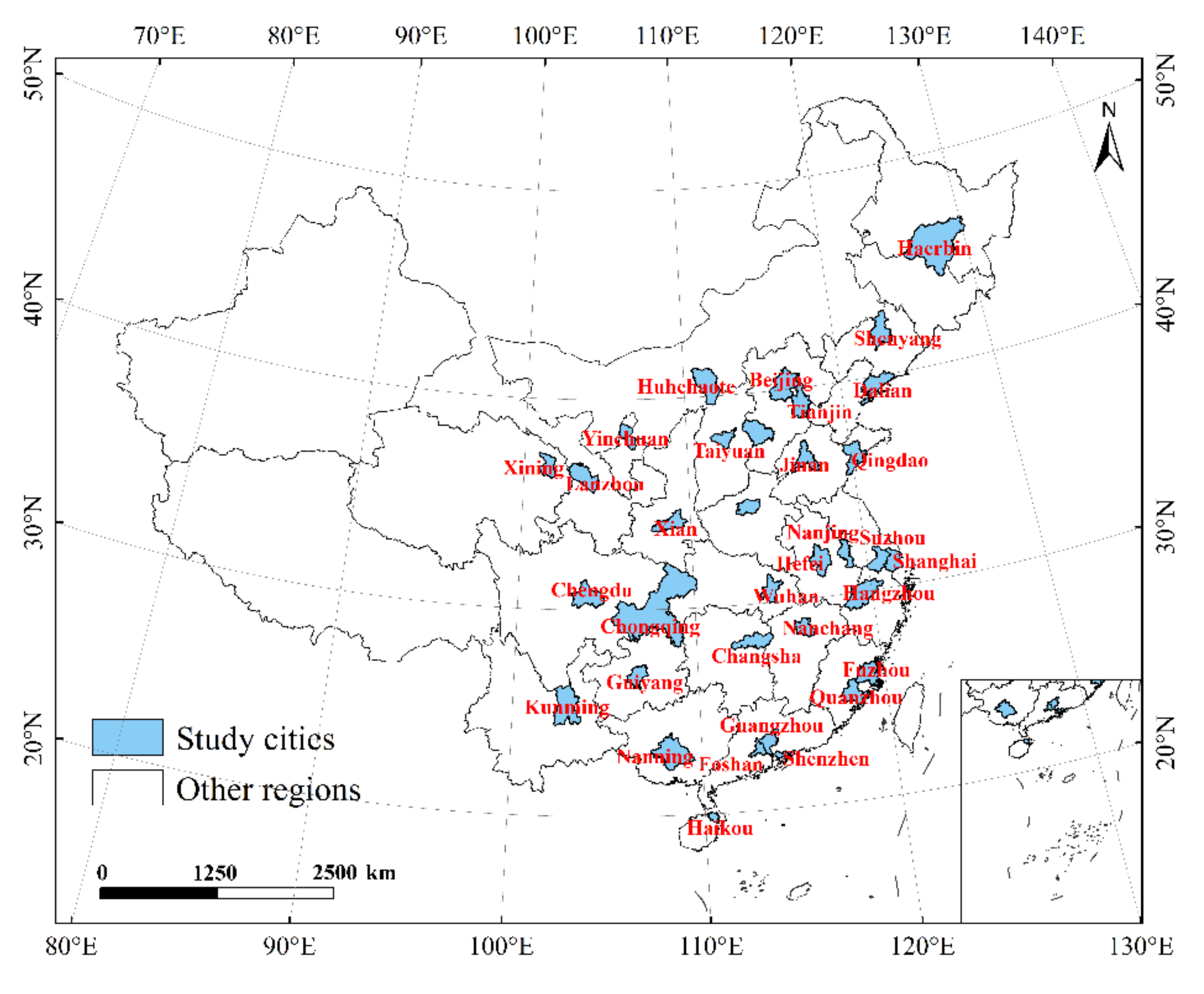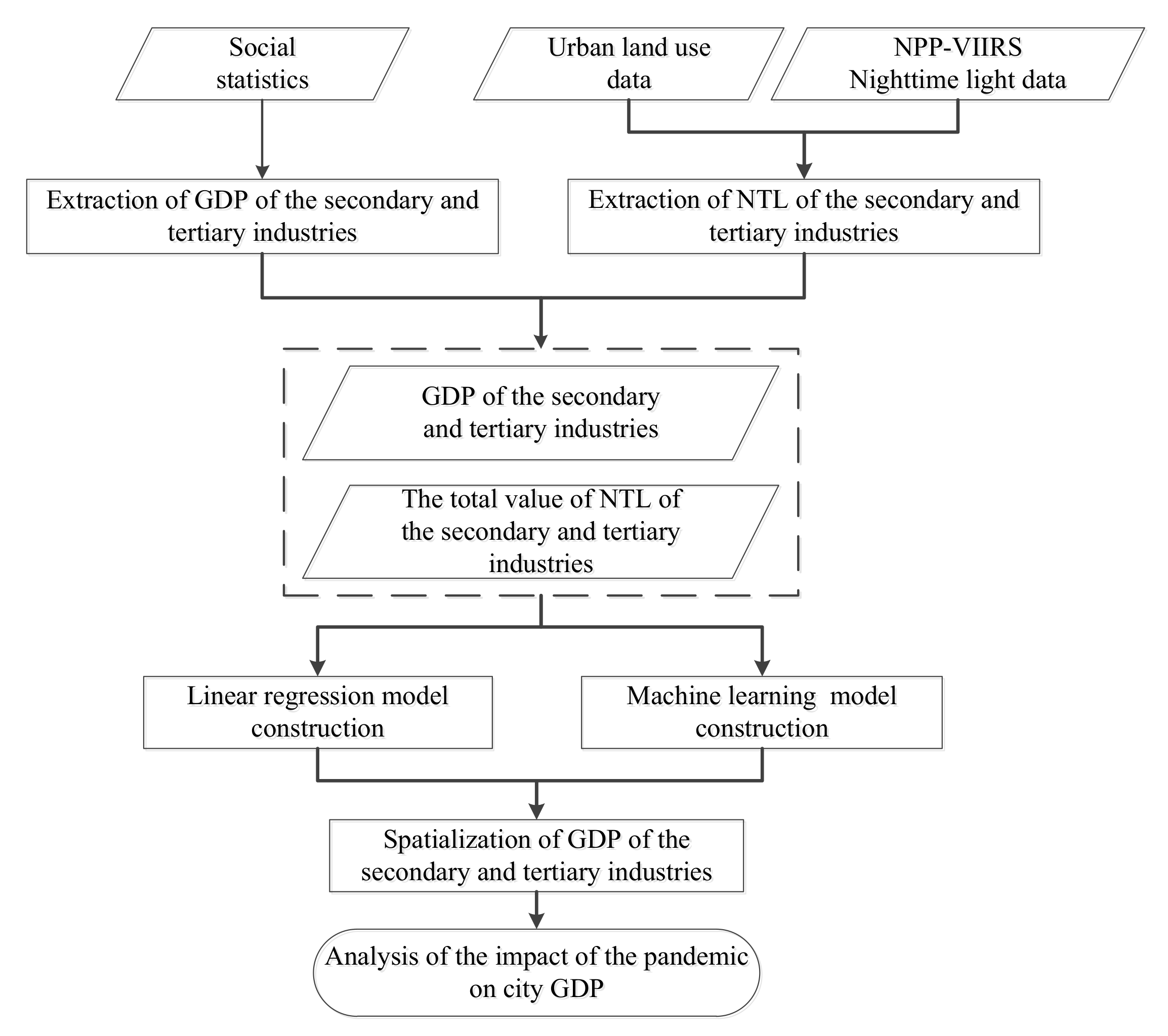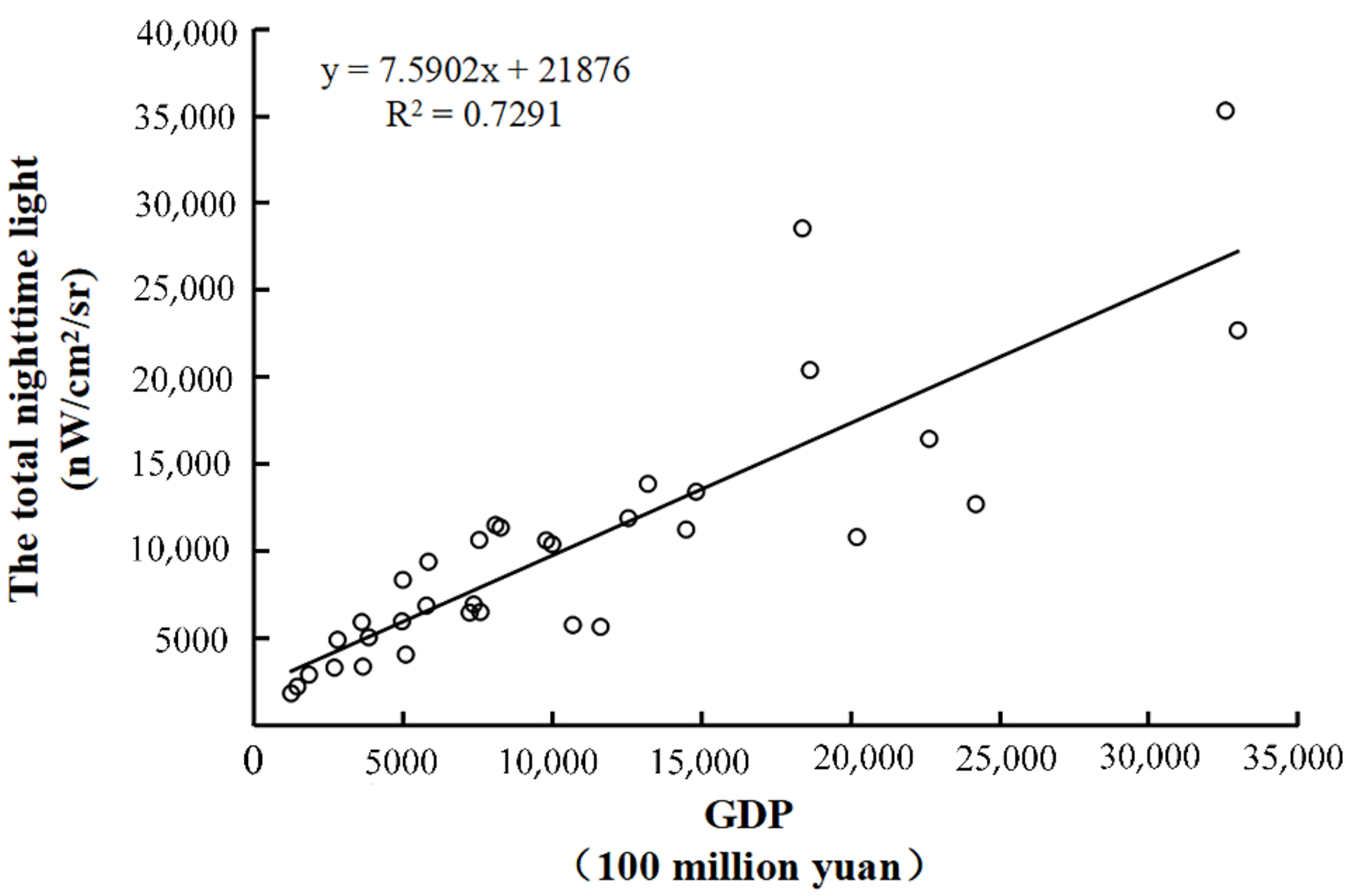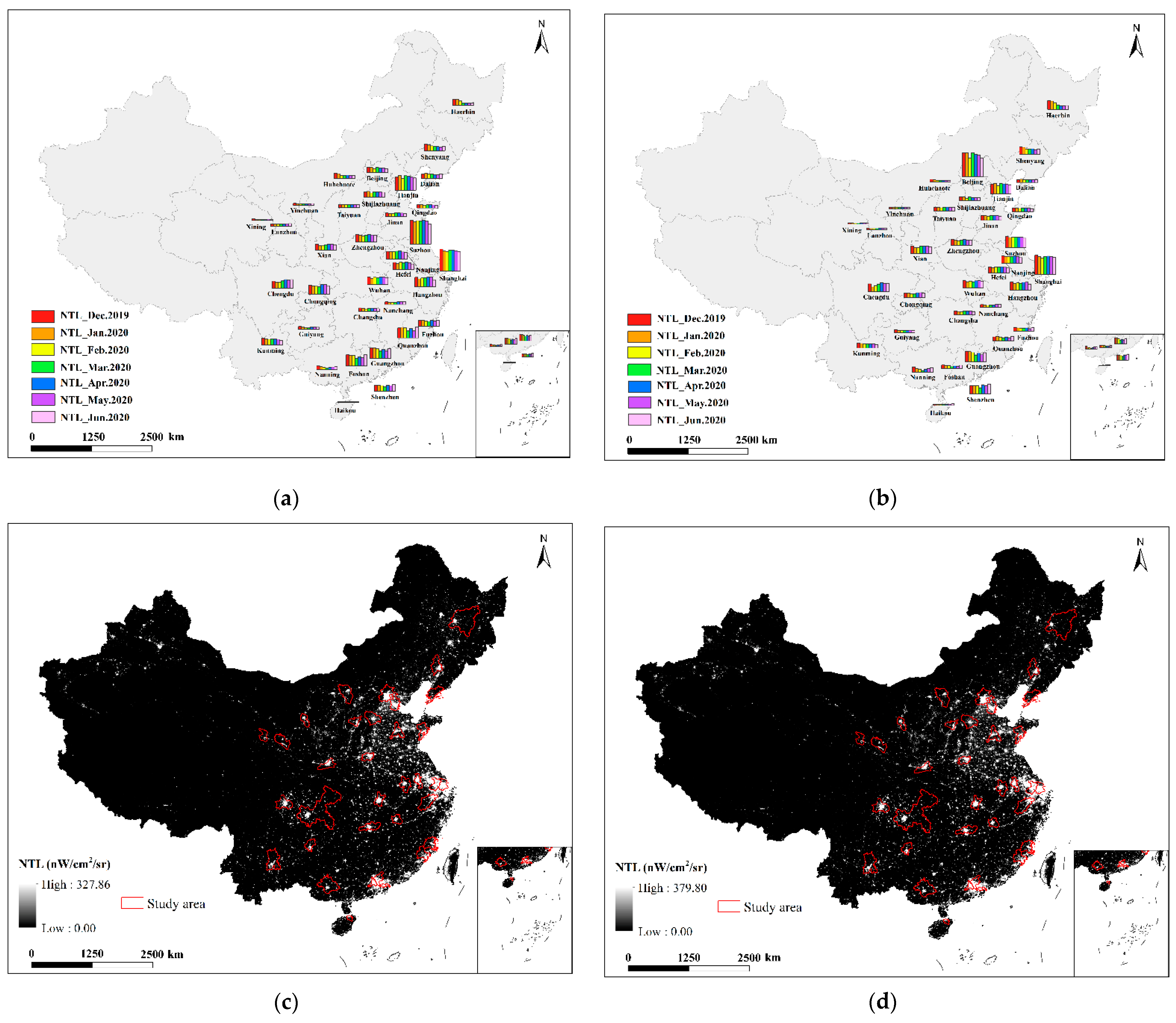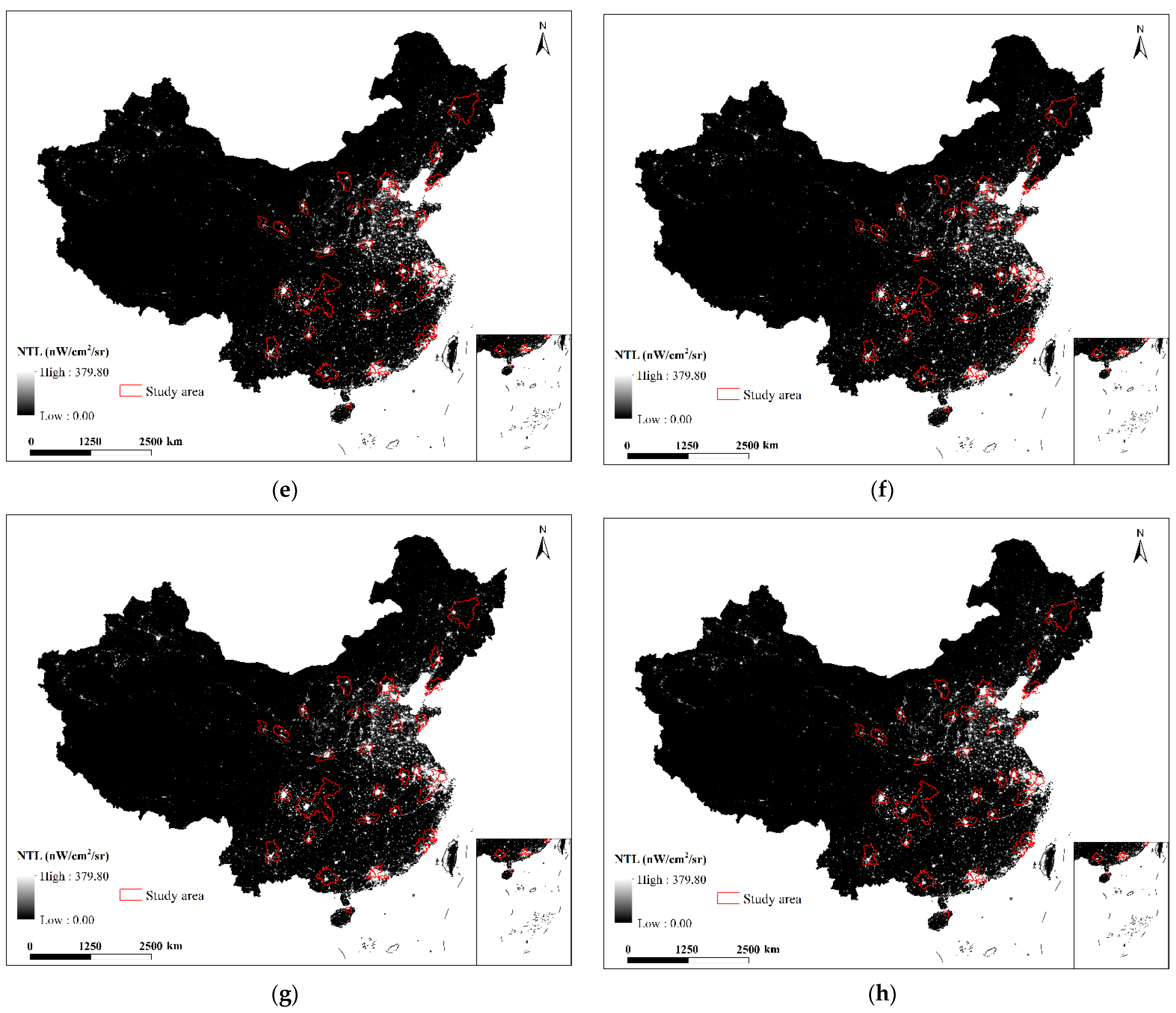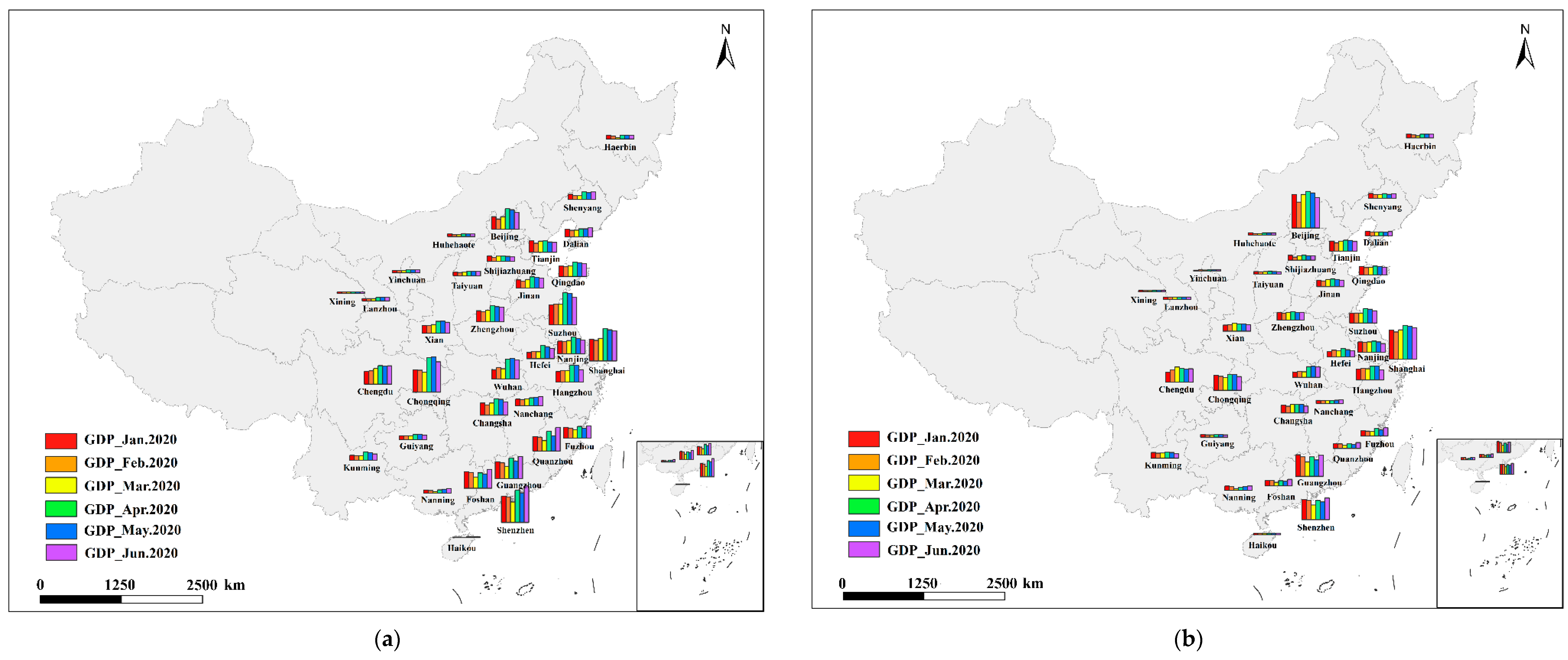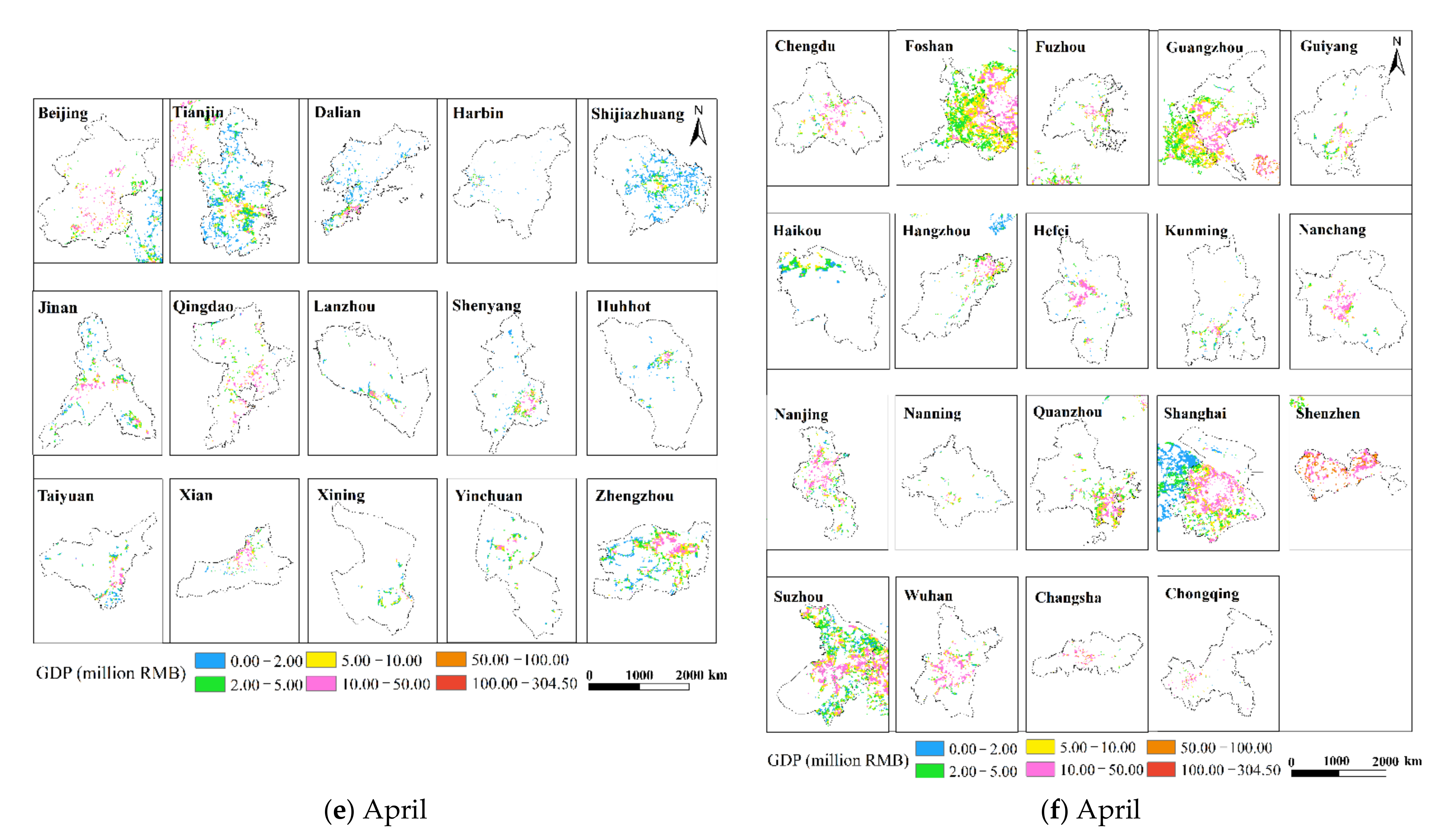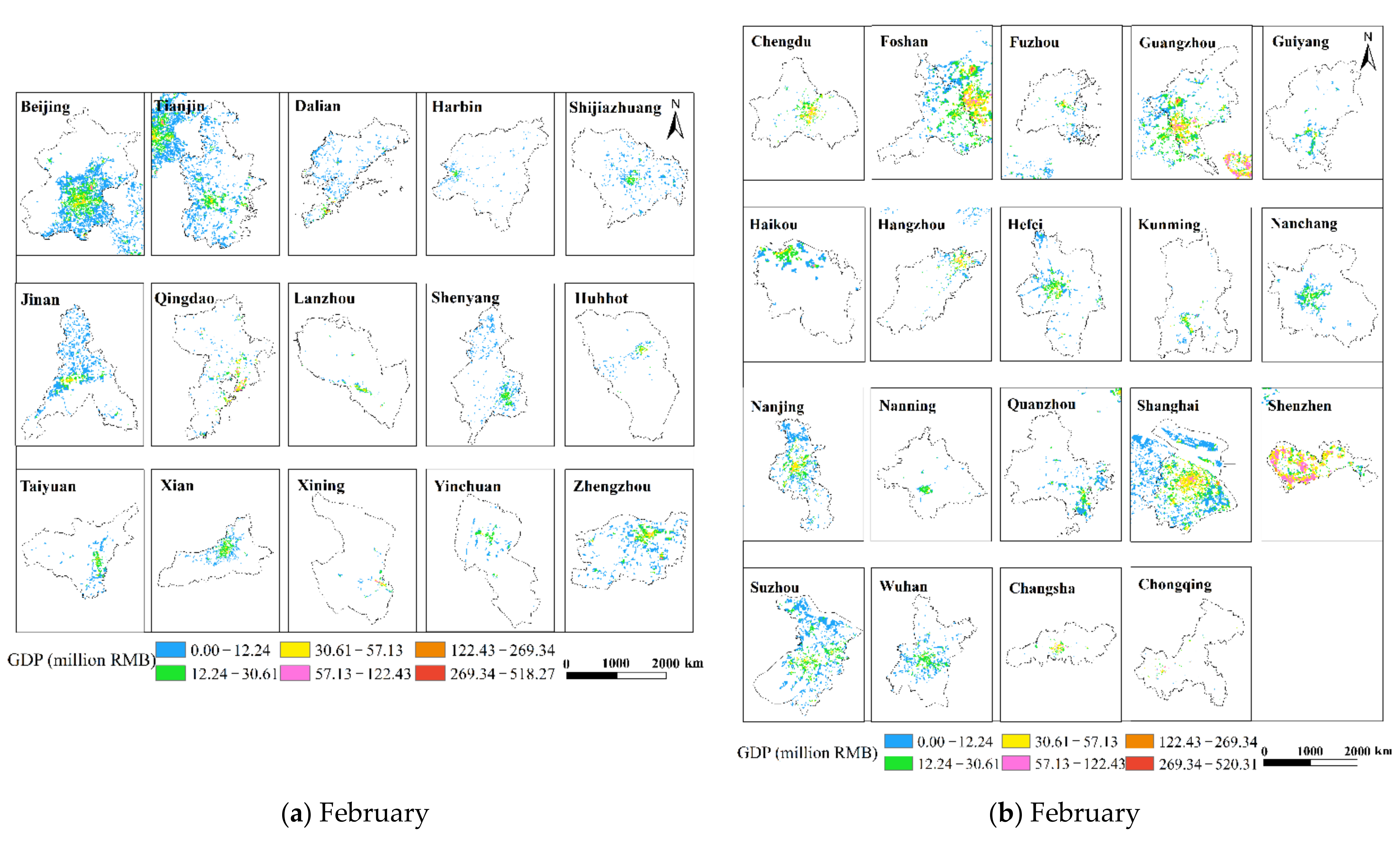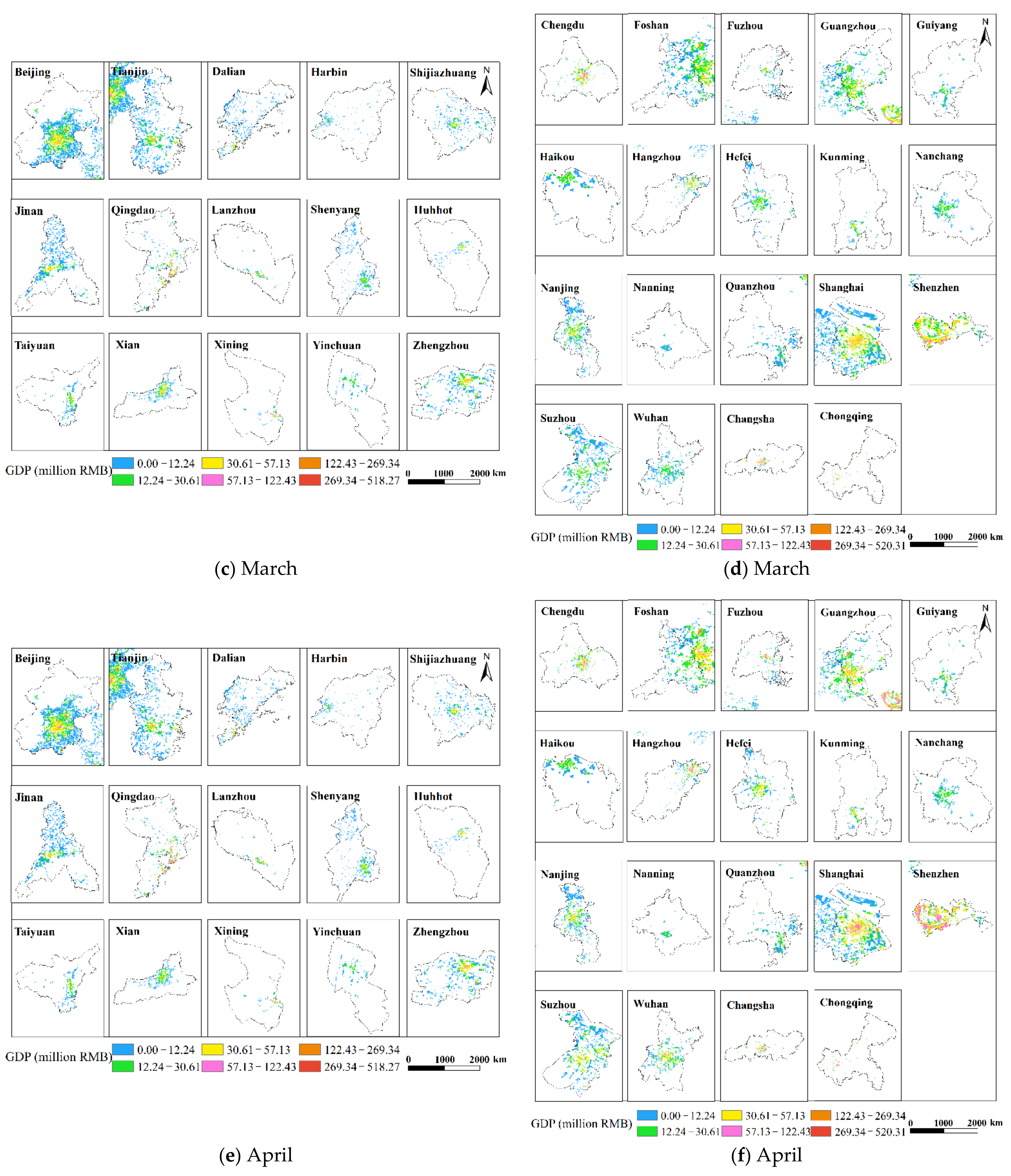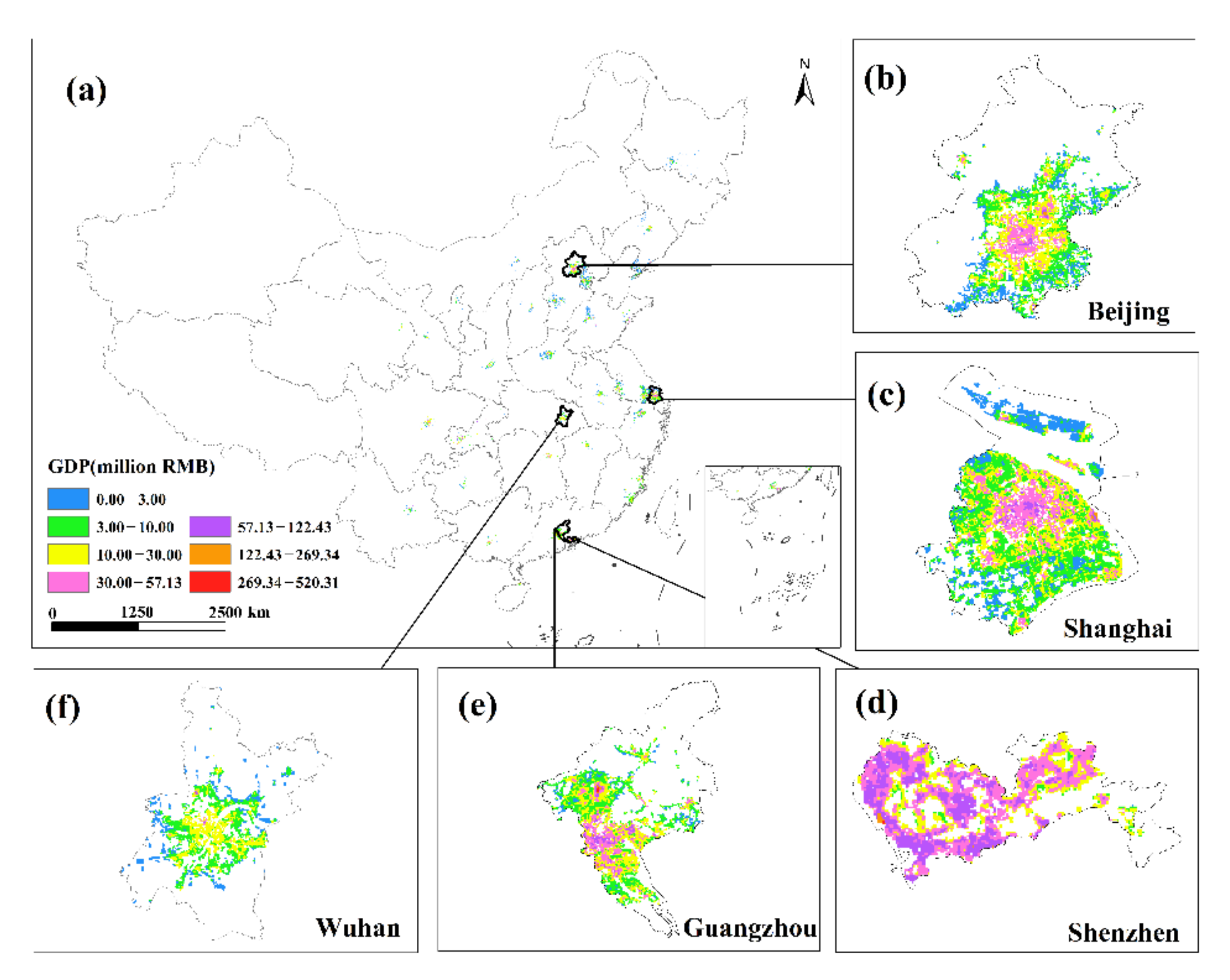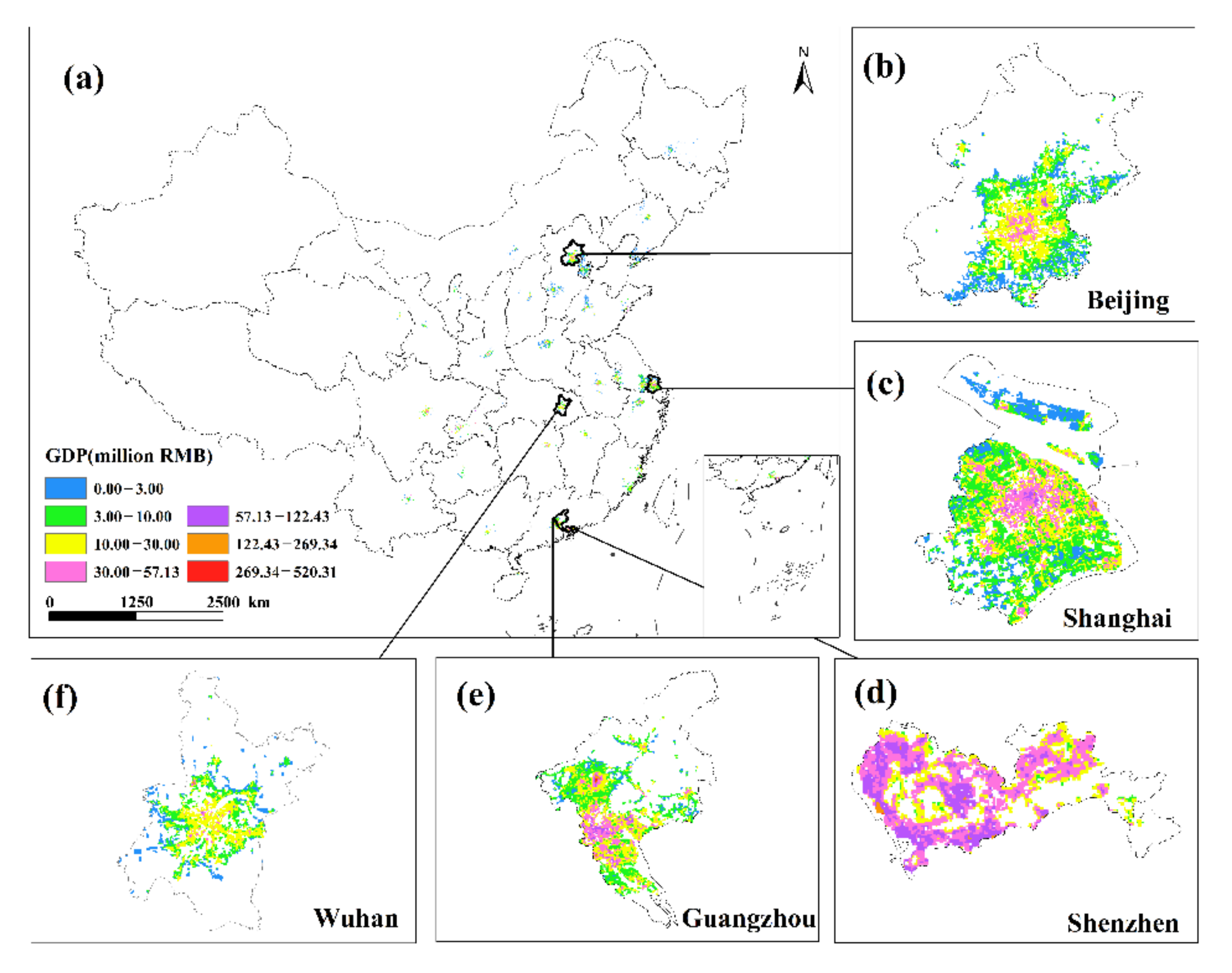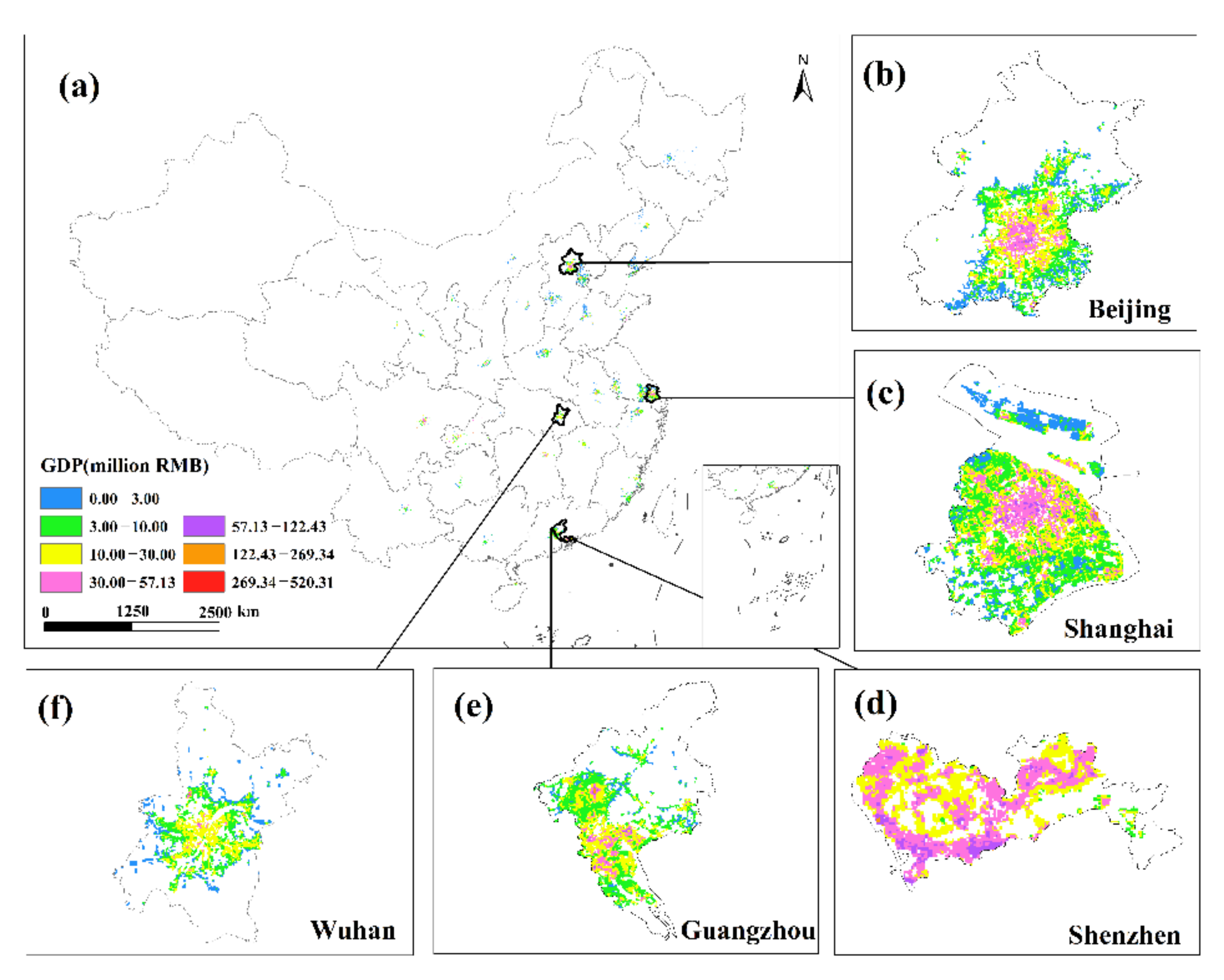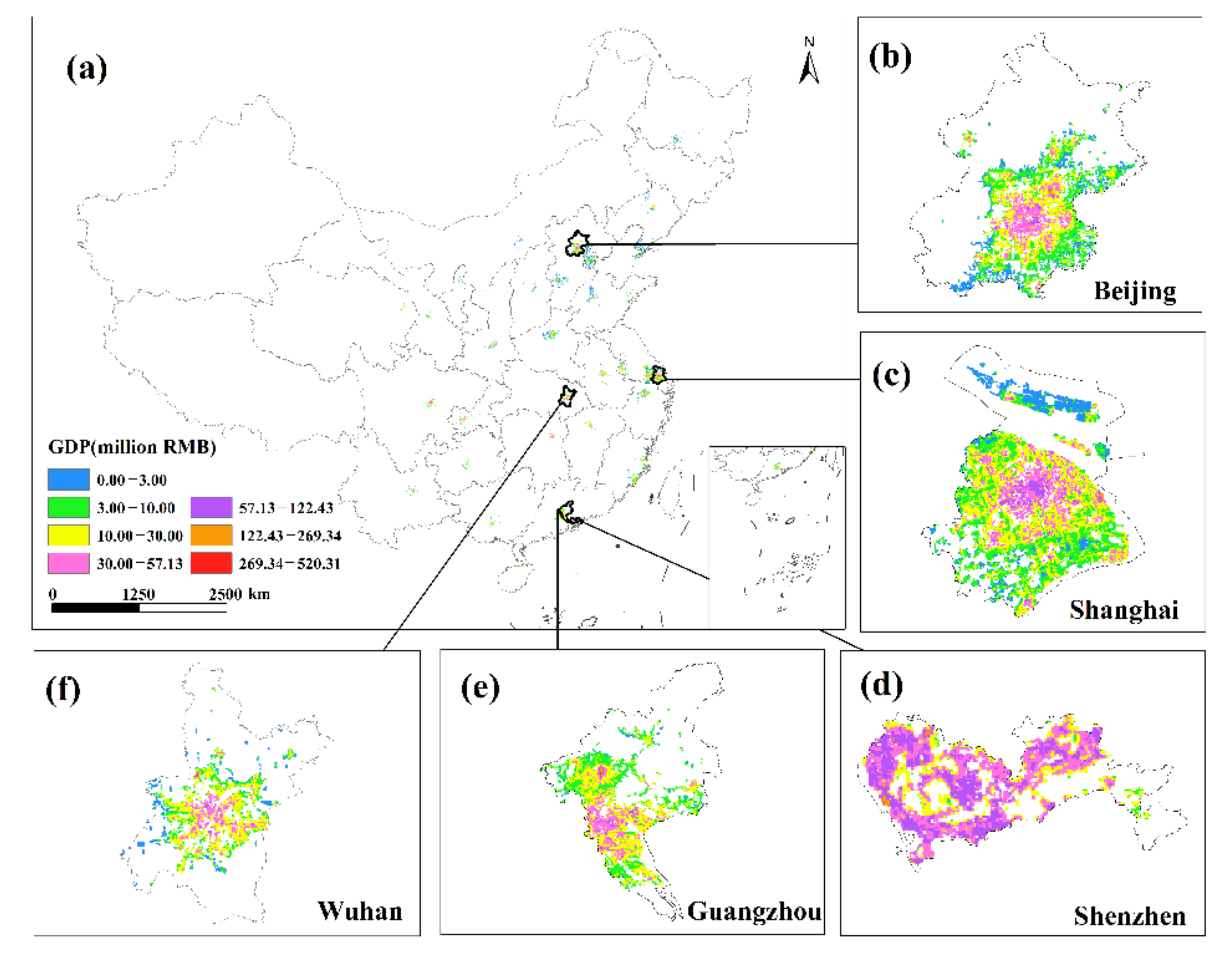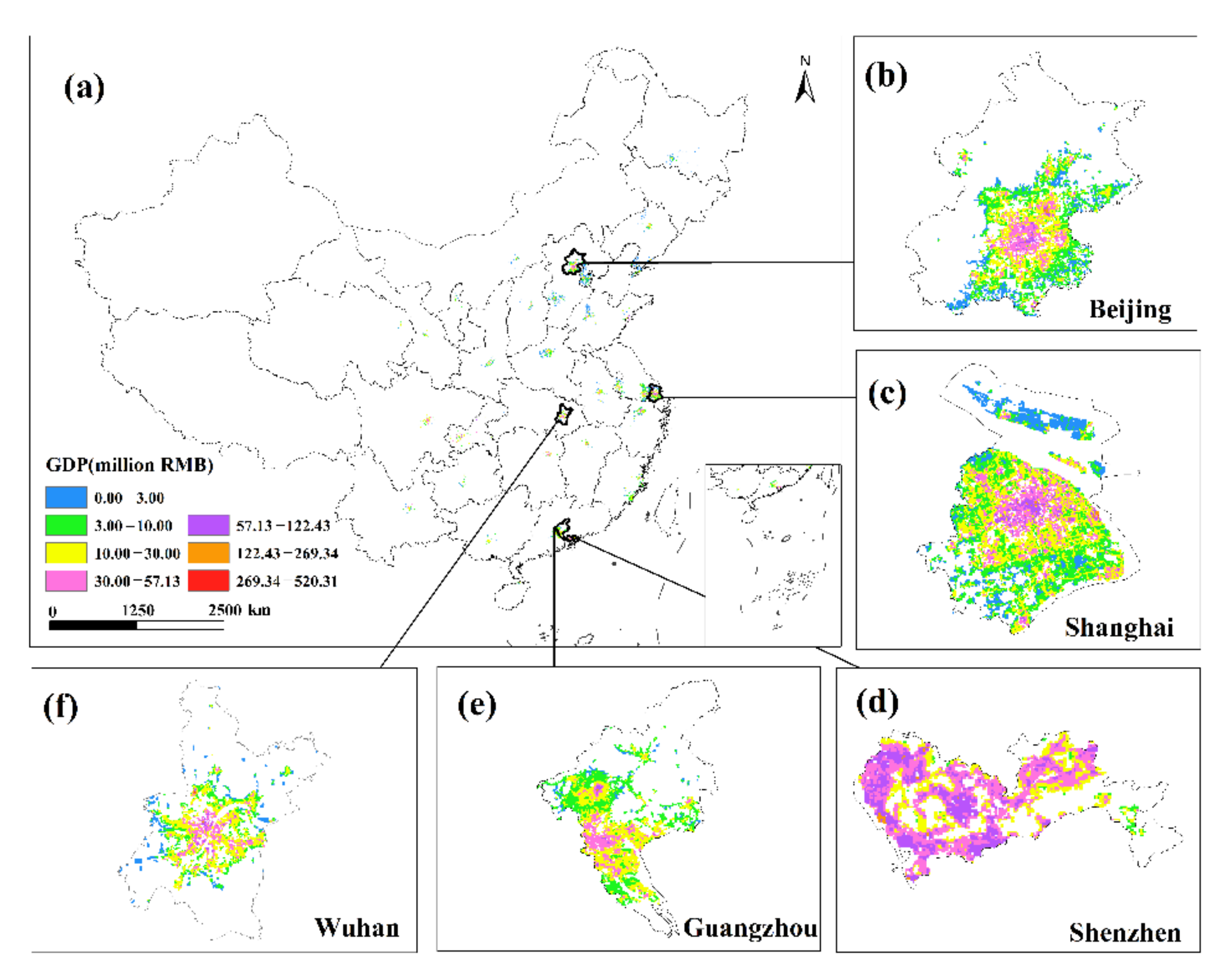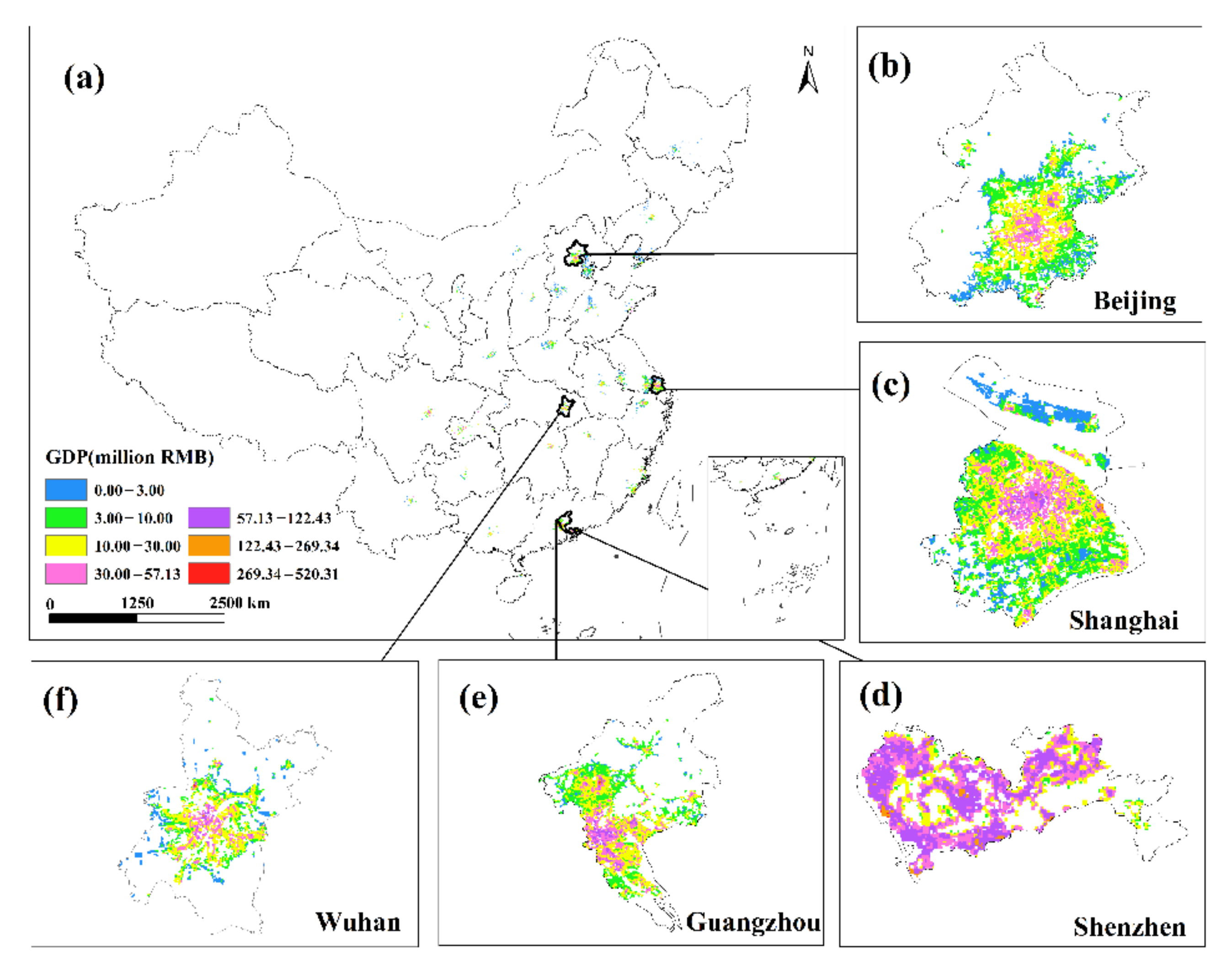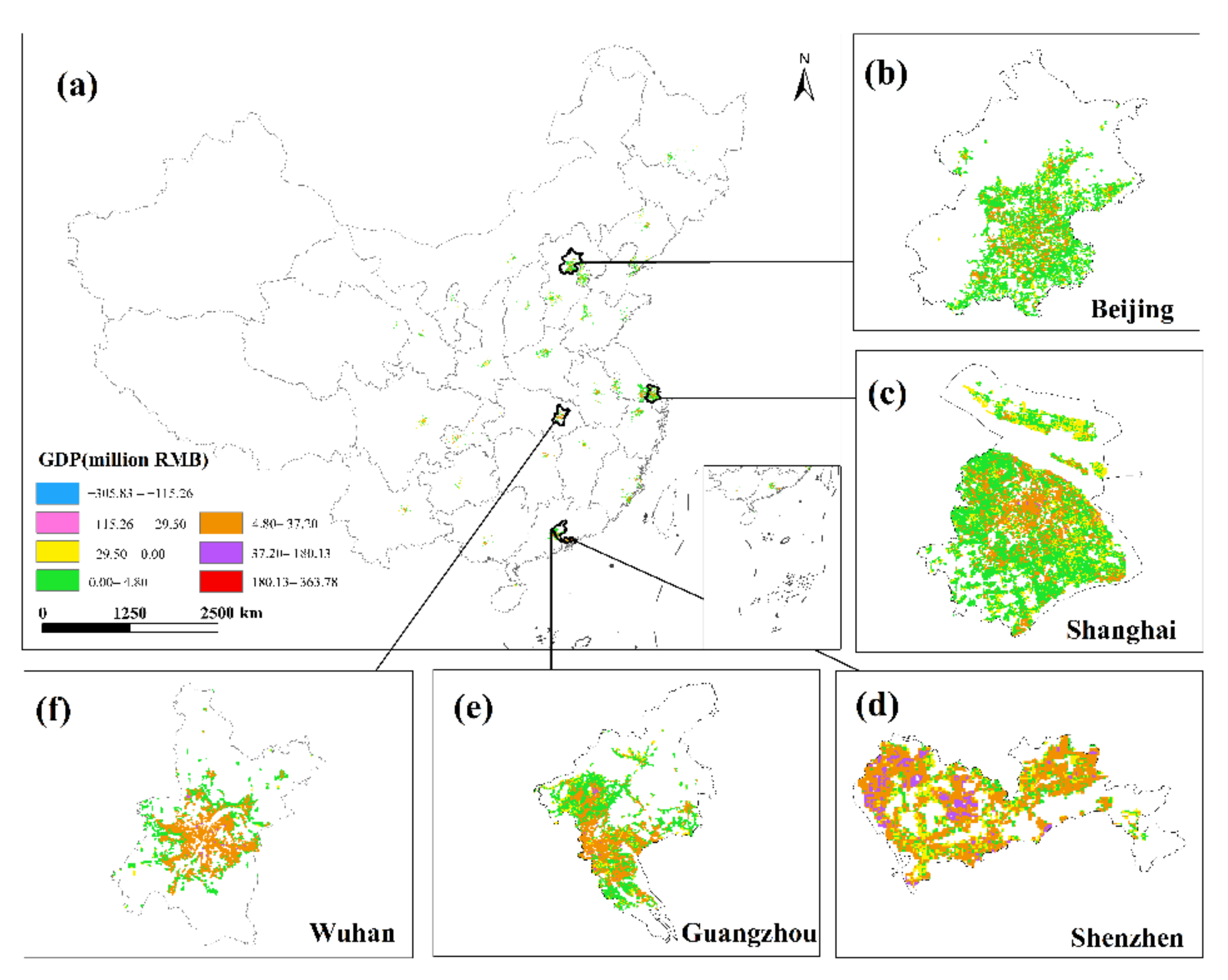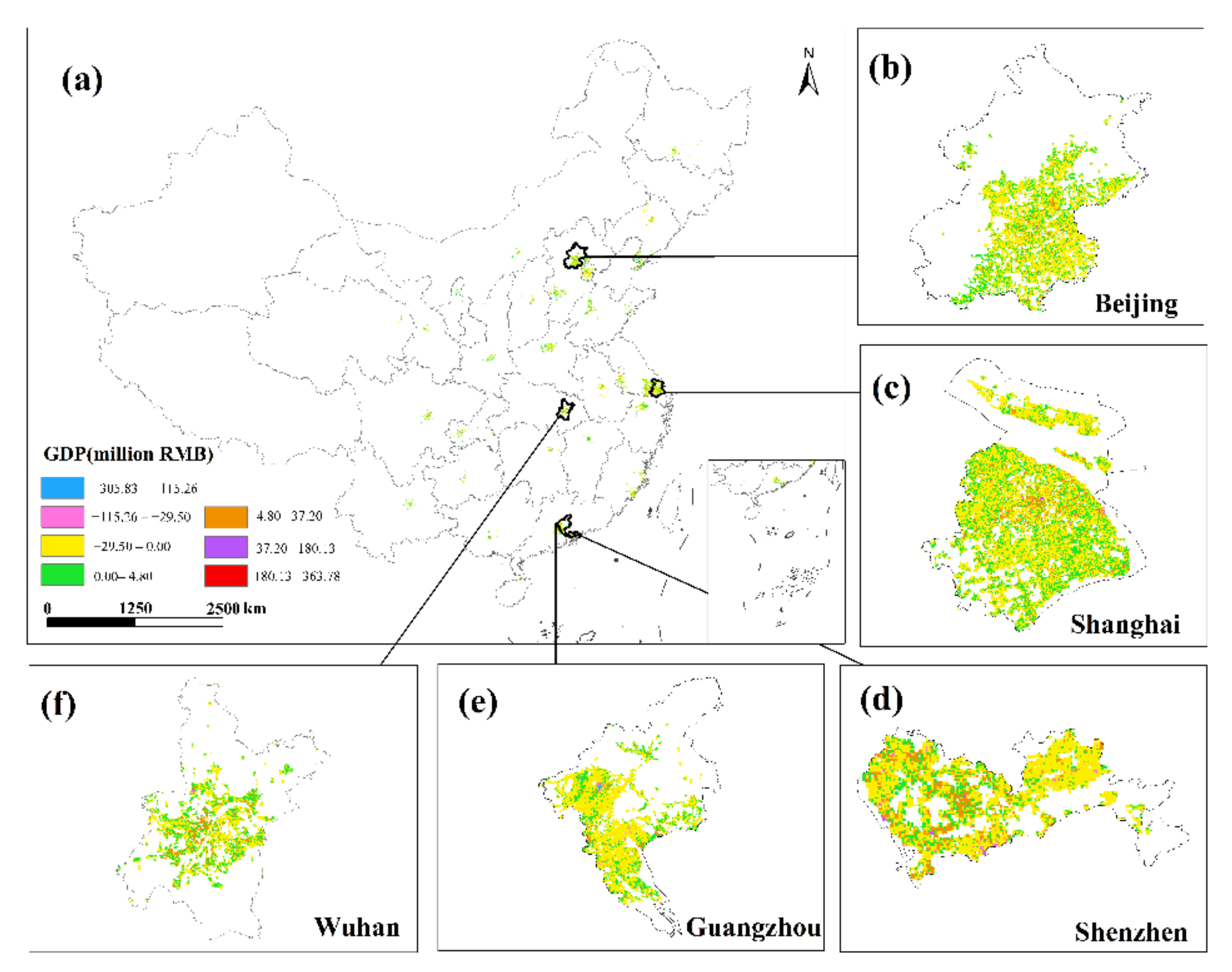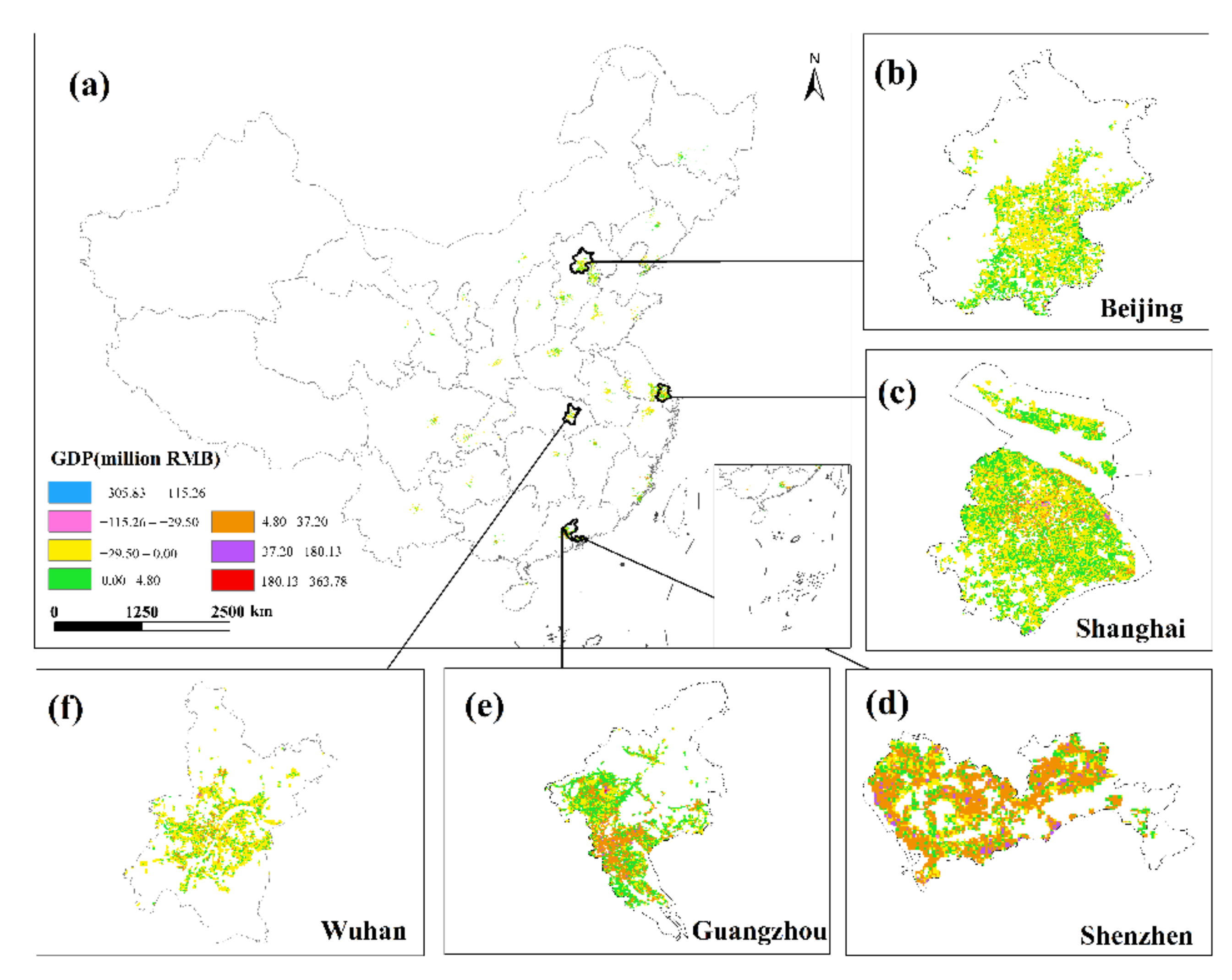3.3. Monthly GDP Revision Results
This study employed a high-precision linear model to estimate the city’s monthly GDP by industry based on monthly NTL images and corrects the estimated GDP so that the estimated GDP and the statistical GDP are consistent on the quarterly scale. From January to June 2020, the subindustry GDP of 34 cities was obtained (
Figure 5). According to the findings, the GDP of the secondary and tertiary industries was obviously affected by the pandemic, but as the pandemic was gradually brought under control, urban economic activities recovered rapidly. Wuhan is the Chinese city most badly hit by the COVID-19 outbreak. Wuhan began a lockdown on January 23, and the Chinese Lunar New Year was on January 25, making the production slowdown in Wuhan in the last week of January more severe. Wuhan eventually resumed some output in February. However, in March, the level of production recovery in Wuhan declined [
37]. Ultimately, Wuhan’s GDP was lower in January and March than in February. With the improvement of the pandemic situation, the GDP of Wuhan’s secondary and tertiary industries increased significantly in the second quarter compared to the first quarter.
The estimated results of the GDP of the secondary industry from January to June are shown in
Table 6. The results indicate that the secondary industry in most cities saw a large drop in GDP in February, when the COVID-19 outbreak was at its peak, with the average GDP falling by 6.99% month over month. Among them, the cities with more serious GDP decline are mainly located in northern China. Cities in southern China have had fewer GDP losses, and some have even experienced GDP growth, which are primarily located in the Yangtze River Delta urban agglomeration and western China. COVID-19 was progressively brought under control in March, and the rate of drop in the secondary industry’s GDP declined month over month, with the average GDP down 0.74%, which was showing that the secondary industry is still recovering. Wuhan abolished the lockdown state on 8 April 2020, which showed that China effectively controlled COVID-19. In April, the GDP of the secondary industry increased swiftly and significantly in most cities, with the average GDP increasing by 54.68% month over month, indicating that the GDP of the secondary sectors in these 34 cities has quickly returned to pre-COVID-19 levels. A small number of new cases in some cities may influence GDP due to China’s strict pandemic prevention and control mechanism, which resulted in a month-on-month fall in secondary industry GDP in May and June. However, in the second quarter of 2020, the overall GDP of the secondary industry in 34 cities was in a stage of rapid recovery.
Table 7 shows the tertiary industry’s estimated GDP from January to June. The results indicate that in February, when the COVID-19 pandemic was at its peak, the tertiary sector in most cities had a considerable drop in GDP. On a month-to-month basis, the average GDP declined by 7.22%. Cities with more serious GDP declines include Beijing, Tianjin, Shenyang, Hohhot, and Wuhan. Among them, Shijiazhuang’s GDP fell the most in February, at 35.22%. However, the GDP of some cities increased slightly in February, such as Hefei, Chengdu, Hangzhou, and other southern Chinese cities and western cities Yinchuan and Xi’an. With the gradual easing of the pandemic in March, the GDP of most cities showed a slow month-on-month growth trend in March, with an average GDP growth of 0.13% month-on-month. Among them, Shijiazhuang experienced a 40.62% month-on-month increase in GDP in March after experiencing a sharp drop in GDP in February. But most cities have not recovered to January’s GDP levels. The return of labor and production across the country went off without a hitch in April, with the average GDP increasing by 23.21% month over month. The cities with larger increases are mainly Wuhan, Nanning, Fuzhou, and Harbin, with their GDP increasing by more than 50% month-on-month. Among them, Wuhan has the largest increase, with its GDP increasing by 97.37% month-on-month, indicating that social and economic activities in most cities have returned to stability. The GDP in May and June were nearly identical. In May and June, the GDP of most cities varied somewhat compared to April. In general, the tertiary industries in 34 cities recovered rapidly in the second quarter.
3.4. GDP Spatialization Results
This research used the corrected NPP-VIIRS NTL data and the spatial correction method to produce the spatialized findings of the monthly GDP of the secondary and tertiary industries in 34 Chinese cities from January to June 2020 based on the GDP estimation model in
Section 2.3.4. The results show that there are obvious differences in the spatiotemporal distribution of GDP in different cities, but there are also certain similarities.
This study only displays the results of the spatial distribution of GDP from February to April because the economic development patterns of cities will not change considerably in a short period of time (
Figure 6 and
Figure 7). The findings reveal that there are huge spatial differences in GDP within each city, as well as large spatial differences between cities. Cities such as Beijing, Shanghai, Guangzhou, Shenzhen, Chongqing, Chengdu and Suzhou have developed economies with relatively high GDP. In these cities, the GDP of many urban construction land is at a high level, and at the same time, these urban construction land has obvious agglomeration. In addition, cities such as Hangzhou, Nanjing, Wuhan, and Tianjin have relatively developed economies, and there are also a small amount of urban construction land with high GDP levels. However, cities such as Yinchuan, Haikou, and Xining have slow economic development, low urbanization rate, and generally low GDP of urban construction land. The economic impact of the COVID-19 pandemic on cities with different levels of economic development and industrial structures will also vary.
This study undertakes an overlay analysis of monthly GDP spatial distribution data in 34 Chinese cities from January to June 2020. The results of the spatial change trend of GDP in the sum of the secondary and tertiary industries from January to June 2020 (
Figure 8,
Figure 9,
Figure 10,
Figure 11,
Figure 12 and
Figure 13). The findings reveal that there are not only large differences in the spatiotemporal changes of GDP between cities, but also significant differences in the spatiotemporal changes of GDP within each city. Cities such as Beijing, Shanghai, Guangzhou, Shenzhen, Hangzhou, Suzhou, and Nanjing are economically developed and have higher GDP. Many urban constructions land in these cities has a high GDP, and there was apparent agglomeration of construction land in these cities. In addition, the economies of Wuhan, Changsha, Tianjin, Chongqing, Chengdu, and other cities are comparatively developed, with a small number of high-level GDP cities. While cities such as Haikou, Lanzhou, Xining, and Yinchuan are experiencing moderate economic growth and low urbanization rates, the GDP of urban building land is generally low. The economic impact of the COVID-19 pandemic on cities with different economic development levels and industrial structures will also vary.
This study investigates the loss and recovery of the monthly GDP of the city’s secondary and tertiary industries during the COVID-19 outbreak using the abovementioned GDP spatialization results and superimposes the GDP spatialization results, using the GDP of the next month minus the GDP of the previous month. In summary, the results of changes in the total urban GDP in January–February, February–March, March–April, April–May, and May–June were obtained (
Figure 14,
Figure 15,
Figure 16,
Figure 17 and
Figure 18), where the sum of GDP represents the sum of the GDP of the secondary and tertiary industries. The findings suggest that during the outbreak, the GDP of most cities plummeted dramatically. The COVID-19 pandemic has had variable degrees of impact on the economic development of several cities in China since Wuhan announced the city’s shutdown on 23 January 2020. The outbreak has had the greatest impact in eastern China, affecting the GDP of Beijing, Shanghai, Guangzhou, Shenzhen, and Wuhan, where the impact of the COVID-19 pandemic was the most visible. In these cities, the GDP of construction land was decreasing. The COVID-19 pandemic has had a greater impact on the economic development of urban construction land with a high GDP level. At the same time, the COVID-19 outbreak has had a significant impact on the economic development of cities such as Chengdu, Chongqing, Hangzhou, Suzhou, and Changsha, with an overall GDP decline. Although the rate of decline was less severe than in established cities such as Shanghai and Guangzhou, the degree of decline in GDP per unit construction land in some cities was also very large. The COVID-19 outbreak has had little impact on the economic development of cities such as Haikou, Lanzhou, and Xining. Although there are also many cities whose GDP per unit construction land was in a downward trend, there were also some cities such as Yinchuan and Xi’an that had a positive growth trend in their GDP per unit construction land.
The GDP of major Chinese cities fell in February 2020 compared to January, but the negative trend in most places had dramatically improved as China’s COVID-19 pandemic was gradually brought under control. Some cities began to restart work in early March, and by the end of the month, the work resumption index in most cities was above 70% [
37]. In March, the economy showed signs of improvement, with the GDP of most major Chinese cities trending upward. In March 2020, cities including Beijing, Shanghai, Shijiazhuang, Changsha, and Tianjin had a noticeable GDP recovery. The GDP per unit construction land in most cities had increased, and the GDP per unit construction land in cities with high GDP growth had increased even more, indicating that these urban building lands had obvious agglomeration. Although some cities, such as Guangzhou, Shenzhen, Wuhan, Harbin, and Quanzhou, have positive GDP per unit of construction land growth, the majority of GDP per unit of construction land growth was negative. The overall level of GDP in March remained in a declining trend, and the economic recovery was slow. Most of these cities’ GDP per unit of building land did not reach a positive growth level until April.
In April, the GDP per unit of construction land in Beijing was in both an increasing trend and a declining trend, but the overall level was still in the GDP growth trend. The GDP growth of unit construction land in Shanghai with a high level of GDP was more significant, and only a small number of cities had a negative growth rate of GDP per unit construction land. The pandemic conditions in several cities resurfaced in May. Most of the urban unit construction land GDP in Beijing, Shanghai, Guangzhou, Shenzhen, Suzhou, Nanjing and other cities was in a state of negative growth. The majority of cities, including Wuhan, Hangzhou, Nanchang, and Nanning, had negative GDP per unit of building land growth, while overall GDP growth was positive. The western region was less affected by the repeated pandemics, and the overall GDP of cities such as Xi’an, Lanzhou, Xining, and Yinchuan is in a positive growth trend. The number of COVID-19 cases climbed in June in Beijing, Shanghai, Guangzhou, Shijiazhuang, Chengdu, and other cities. As a result of the recurring pandemic, the GDP of each city has shown different trends. Most of the cities such as Beijing, Shanghai, Suzhou, Tianjin, and Chongqing had positive growth in GDP per unit of construction land, while some GDP per unit of construction land was in a state of negative growth, but the overall level of GDP was in a negative growth level. In most cities, such as Guangzhou, Shenzhen, Fuzhou, and Quanzhou, the GDP per unit of construction land was increasing, and the overall GDP was rising as well; in some cities, such as Wuhan and Hangzhou, the GDP per unit of construction land was decreasing, but the overall level of GDP was increasing.
